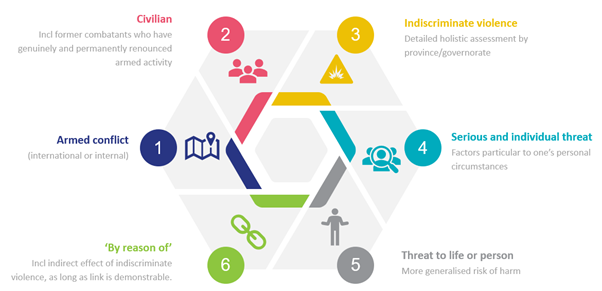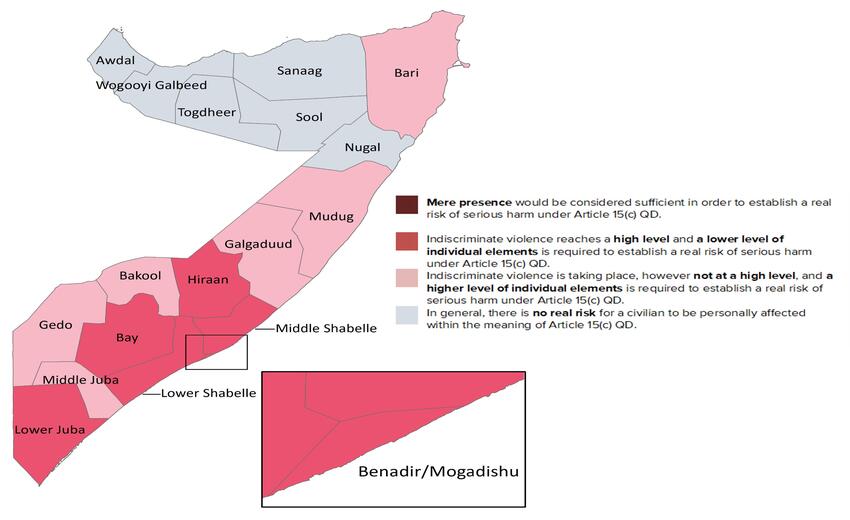Serious and individual threat to a civilian’s life or person by reason of indiscriminate violence in situations of international or internal armed conflict
GUIDANCE NOTE
Last updated: June 2022
The necessary elements in order to apply Article 15(c) QD are:
Figure 3. Article 15(c) QD: elements of the assessment.

In order to apply Article 15(c) QD, the above elements should be established cumulatively.
The following is a summary of the relevant conclusions concerning the situation in Somalia:
a. Armed conflict:
Several conflicts/rivalries take place in the territory of Somalia:
- Al-Shabaab – anti Al-Shabaab armed conflict: a non-international armed conflict with Al-Shabaab is taking place in Somalia, while the group controls parts of the country. The FGS, the FMS, some clans, as well as other international actors, such as Ethiopia, Kenya, the US, and AMISOM, are all engaged, in various degrees and forms, in the long-standing conflict against Al-Shabaab.
- The inter and intra-clan rivalries: clans often compete against each other, as well as against other actors such as the FGS or the FMS. The existence of clan militias has been reported throughout Somalia, including Puntland and Somaliland. In some cases, clan rivalries have escalated to armed confrontations, therefore taking the form of an armed conflict in the meaning of Article 15(c) QD.
- Anti-ISS armed conflict: various armed forces, including AFRICOM, the Federal Security Forces, and the Puntland armed forces are engaged in various degrees in an armed conflict against ISS. While ISS is mainly active in Puntland, it carries out attacks also in Mogadishu and elsewhere. Furthermore, Al-Shabaab and ISS also fight against each other.
- Puntland versus Somaliland: Puntland and Somaliland contend over control of areas of the Sool and Sanaag regions as well as the area of Ayn, part of Togdheer region. In this context, clashes were reported in the beginning of 2020.
- Other rivalries: other types of confrontations which do not necessarily develop into armed confrontations are taking place in Somalia. These include: the FGS versus the FMS, the intra-FMS control and governance dynamics, the FGS versus Somaliland. In some occasions, armed confrontations have been reported.
- Members of the FGS security forces, including the SNA, special forces, NISA and Somali Police Force (SPF)
- Members of the FMS armed forces
- Members of the Somaliland armed forces
- Al-Shabaab members
- Members of clan militias
- ISS members.
It should be noted that actively taking part in hostilities is not limited to openly carrying arms but could also include substantial logistical and/or administrative support to combatants.
It is important to underline that the assessment of protection needs is forward-looking. Therefore, the main issue at hand is whether the applicant will be a civilian or not upon return. The fact that the person took part in hostilities in the past would not necessarily mean that Article 15(c) QD would not be applicable to him or her.
c. Indiscriminate violence: indiscriminate violence takes place to a different degree in different parts of the territory of Somalia. The map below summarises and illustrates the assessment of indiscriminate violence per region in Somalia. This assessment is based on a holistic analysis, including quantitative and qualitative information for the reference period (primarily, 1 January 2020 - 30 June 2021). Up-to-date country of origin information should always inform the individual assessment.
It should be noted that there are no regions in Somalia where the degree of indiscriminate violence reaches such a high level that substantial grounds are shown for believing that a civilian, returned to the relevant country or, as the case may be, to the relevant region, would, solely on account of their presence on the territory of that country or region, face a real risk of being subject to the serious threat referred to in Article 15(c) QD.
For the purposes of the guidance note, the regions of Somalia are categorised as follows:
Figure 4. Level of indiscriminate violence in Somalia (based on information up to 30 June 2021).

|
|
Territories where ‘mere presence’ in the area would not be sufficient to establish a real risk of serious harm under Article 15(c) QD, however, indiscriminate violence reaches a high level, and, accordingly, a lower level of individual elements is required to show substantial grounds for believing that a civilian, returned to the territory, would face a real risk of serious harm within the meaning of Article 15(c) QD. This includes the regions of Bay, Benadir/Mogadishu, Hiraan, Middle Shabelle, Lower Juba and Lower Shabelle. |
|
|
Territories where indiscriminate violence is taking place, however not at a high level and, accordingly, a higher level of individual elements is required in order to show substantial grounds for believing that a civilian, returned to the territory, would face a real risk of serious harm within the meaning of Article 15(c) QD. This includes the regions of Bakool, Bari, Galgaduud, Gedo, Middle Juba and Mudug. |
|
|
Territories where, in general, there is no real risk for a civilian to be personally affected within the meaning of Article 15 (c) QD. This includes the regions of Awdal, Nugal, Sanaag, Sool, Togdheer and Wogoyi Galbeed. |
d. Serious and individual threat: in the context of the ‘sliding scale’, each case should be assessed individually, taking into account the nature and intensity of the violence in the area, along with the combination of personal circumstances present in the applicant’s case. Certain personal circumstances could contribute to an enhanced risk of indiscriminate violence, including its direct and indirect consequences. While it is not feasible to provide exhaustive guidance what the relevant personal circumstances could be and how those should be assessed, the following are highlighted as possible examples of circumstances which may impact the ability of a person to assess and/or avoid risks related to indiscriminate violence in a situation of an armed conflict:
- age
- health condition and disability, including mental health issues
- economic situation
- knowledge of the area
- occupation and/or place of residence
- family members or clan/support network
e. Threat to life or person: the risk of harm as per Article 15(c) QD is formulated as a ‘threat to a civilian’s life or person’ rather than as a (threat of) a specific act of violence. Some of the commonly reported types of harm to civilians’ life or person in Somalia include killings, injuries, abductions, forced displacement, famine caused by food insecurity, etc.
- harm which is directly caused by the indiscriminate violence or by acts that emanate from the actors in the conflict, and
- harm which is indirectly caused by the indiscriminate violence in a situation of armed conflict. Indirect effects are only considered to a certain extent and as long as there is a demonstrable link with the indiscriminate violence, for example: widespread criminal violence as a result of lawlessness, destruction of the necessary means to survive, destruction of infrastructure, denial of or limited access to humanitarian aid. Armed clashes and/or closure or destruction of roads can also lead to food supply problems that cause famine or to limited or no access to healthcare facilities in certain areas of Somalia.

